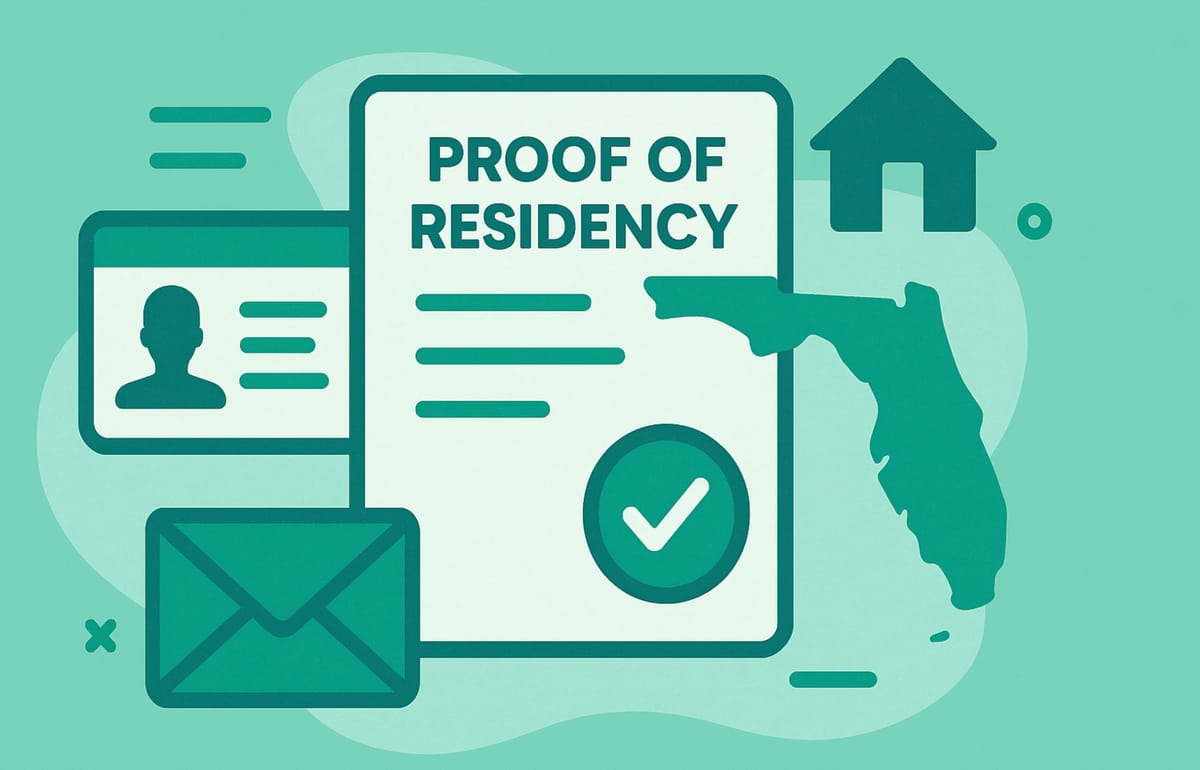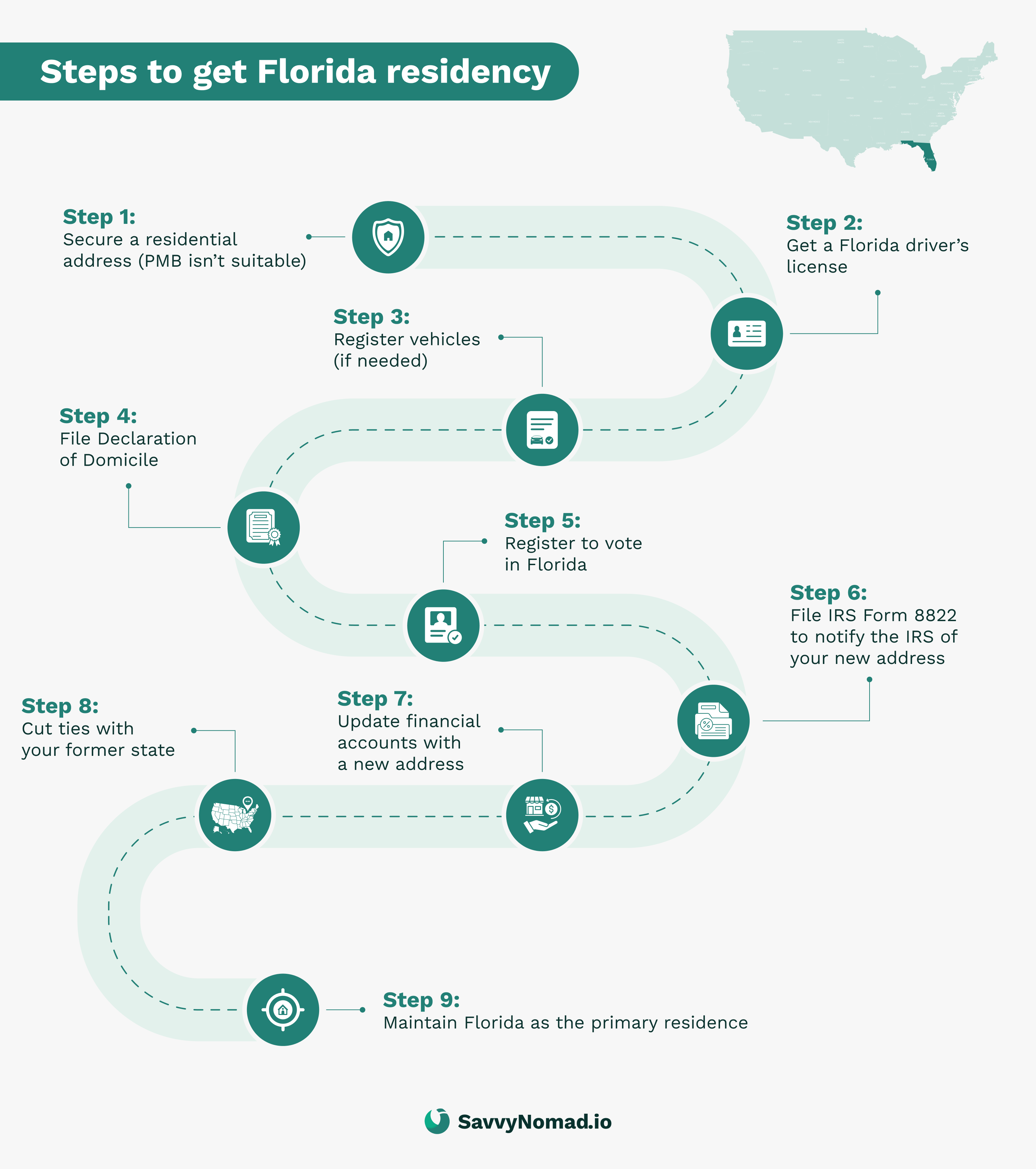Proof of Residency in Florida

Establishing Florida residency can be life-changing—unlocking significant tax savings, protecting your assets, simplifying your financial life, and giving you access to everything from a Florida driver’s license to lower insurance rates.
Yet, for expats, digital nomads, retirees, or frequent travelers, proving you’re a Florida resident often feels complicated and confusing.
A driver’s license is a key piece of identification and proof of residency needed to open an account at a financial institution in Florida.
Understanding the acceptable proofs for residency verification, such as primary and alternate documents, is crucial for obtaining a Florida driver's license or ID.
But it doesn’t have to be.
This guide provides a clear roadmap, step by step, explaining how to establish—and clearly document—your residency in Florida, even if you’re always on the move or rarely spend extended periods in one place. You’ll learn what documentation you’ll typically need, how to avoid common mistakes, and how to maintain your residency with simple, repeatable steps year after year.
Ready to officially make Florida your home, no matter where life takes you? Here’s everything you need to know.
Proof of residency for a Florida driver license (DMV)
One of the first—and most critical—steps in officially calling Florida your home is getting your Florida driver’s license or state ID. In Florida, you’ll obtain these at your local Tax Collector's Office (often referred to as the DMV elsewhere). But there’s a catch: You’ll need two separate documents clearly showing your name and a valid Florida residential address.
If you’ve just landed in Florida or spend most of your time traveling or abroad, producing these documents quickly can seem challenging. Fortunately, Florida accepts several types of proof, ranging from documents that can be obtained instantly to those that require more time and effort.
Below is a complete list of accepted proofs, sorted from easiest (quickest to obtain) to hardest (most time-consuming):
Here’s what Florida accepts as proof of address, ranked from easiest to hardest:
Easy (minutes to hours):
- Credit Card or Bank Statement: Change your address online, download a PDF statement with your new Florida address, and print it.
- Residential Lease Agreement: Even month-to-month leases count—no need for a long-term commitment. A clear, signed PDF is acceptable (SavvyNomad can provide this to you immediately upon joining).
- Welcome Letter from a Residential Provider: A letter from a property management company or residential provider confirming your residency (SavvyNomad issues this welcome letter instantly upon registration).
Moderate (days):
- Utility or Internet Bill: A recent bill in your name from an electricity, water, internet, or cable provider (SavvyNomad can set this up and issue your first utility bill quickly).
- Voter Registration Confirmation: Register online; Florida issues an immediate PDF confirmation that’s valid proof until the physical card arrives.
- Vehicle Insurance Card: Update your address through your insurer’s online portal or app and download the new insurance card immediately.
- Declaration of Domicile: An official declaration filed and stamped by your Florida county clerk, affirming your intent to reside permanently (note: some Florida counties no longer accept this document as proof of residency for DMV purposes).
Takes some effort (weeks to months):
- Florida Vehicle Registration: Update your car registration online (if already titled in your name) or visit a Florida DMV office.
- Employer Pay Stub, Paycheck Stub, or 1099: Payroll or independent-contractor statements issued with your Florida address. Ensure the paycheck stub is recent, dated within the last 60 days.
- Official Government Mail: Any official correspondence like a jury summons or tax bill addressed to your Florida residence.
- Florida Property-Tax Bill or Homestead-Exemption Letter: Excellent proof if you own property—but typically available only annually.
- Recorded Deed or Mortgage Statement: Property ownership documents clearly showing your Florida residential address.
- Notarized Affidavit of Residence: If you live with someone else, you’ll need a notarized affidavit plus a utility bill from the homeowner, or a monthly mortgage statement.
Can I use a virtual mailbox or P.O. Box for proof of address in Florida?
Short answer: No—not for the residential address most agencies require.
You may list a P.O. box/virtual mailbox as a mailing address, but your license, utility account, and Declaration of Domicile must point to a residential street address.
Driver’s license (FLHSMV)
- What Florida requires: Proof of identity, proof of SSN, and two different proofs of a Florida residential street address in your name (printouts accepted).
- What doesn’t work: P.O. boxes, virtual mailboxes (CMRAs), UPS stores, out-of-state addresses for the residential field.
- Solution: SavvyNomad provides a bona fide Florida residential street address plus supporting documents—typically a lease in your name (Proof #1) and a utility setup/first bill or bank/insurance statement to that address (Proof #2)—designed to match what Florida clerks commonly request. You also get a DMV-prep checklist so you can walk in better prepared and reduce the risk of document issues. Final acceptance of any document is always up to the individual clerk and office.
Voter registration in Florida
- What Florida requires: A home (residential) address to place you in the correct precinct. A mailing address is optional and can be a P.O. Box, but the residential line must be a street address where you claim domicile.
- What doesn’t work: Listing a P.O. Box or virtual mailbox as your residence. (Those are mailing-only.)
- Solution: SavvyNomad supplies a Florida residential address that can support your domicile documentation and guides you through the voter-registration flow (online or paper), helping you complete your residential and mailing fields in a way that’s consistent with your broader Florida residency record. Eligibility and acceptance are ultimately determined by Florida election officials.
Declaration of Domicile (county clerk recording)
- What Florida requires: You swear you “reside in and maintain a place of abode” in the county—i.e., a real dwelling, not a mailbox—then record the declaration with the clerk (in person or by mail).
- What doesn’t work: Listing a P.O. box/virtual mailbox as your place of abode.
- How SavvyNomad fits: We provide the Florida residential address, a county-ready DoD template, and step-by-step recording instructions (including remote online notarization options and clerk mailing details). We also route the recorded original or certified copy back to your Florida address so that your paper trail stays organized and consistent.
Introduction to residency
To obtain a Florida driver's license or ID card, applicants must provide proof of Florida residency, which includes presenting a valid driver's license or state ID. This requirement stems from the REAL ID Act, which aims to enhance the security and integrity of state-issued identification documents.
The Florida Department of Highway Safety and Motor Vehicles (FLHSMV) mandates that applicants submit two proofs of residential address in their name to establish Florida residency. These documents can include a utility bill, lease agreement, or mortgage statement, and must be dated within the last 30 days.
Additionally, applicants may need to provide a valid Social Security number and proof of identity, such as a birth certificate or passport. Having these documents ready in advance will streamline the process and make it easier to officially call the Sunshine State home.
Domicile ≠ day-count
You might have heard you need to spend at least 183 days a year in Florida to qualify as a resident. This rule is a common misconception—it originates from high-tax states trying to hold onto residents, not from Florida itself.
Under Florida law—particularly statutes §196.015 (Homestead) and §222.17 (Declaration of Domicile)—residency is evaluated differently. What truly matters to Florida authorities is:
- Your intent to make Florida your permanent legal home.
- Objective evidence (documentation and actions) demonstrating that intent.
Think of domicile as your permanent home base—the place you always intend to return to after periods away. By contrast, residence simply refers to where you’re physically present at any given moment. Establishing domicile requires documented intent rather than just counting days.

The three-pillar test Florida auditors use
To verify your Florida residency, Florida and auditors from other states rely on three core pillars:
- Physical Presence: Even brief visits to Florida matter, especially when tied to major life events such as obtaining a driver’s license at your local Tax Collector Office, registering to vote, opening a bank account, or visiting healthcare providers.
- Paper Trail: Documentation consistently showing your Florida address, including residential lease agreements or property deeds, utility bills, bank statements, voter registration, and a Florida-issued driver’s license or state ID.
- Community Ties: Evidence that your life is actively rooted in Florida, such as homestead exemption filings, memberships in local organizations (clubs, churches, gyms), Florida-based insurance policies, and ongoing relationships with local healthcare providers.
Clearly documenting these three pillars can help you build a strong legal claim of Florida domicile. If another state challenges your residency, your best defense is this robust and consistent documentation—not simply the number of days spent physically in Florida.
With the legal groundwork clearly laid out, the next sections detail exactly how you can obtain and present the required documentation—beginning with one of the most critical residency tests you’ll face: obtaining your Florida driver’s license or state ID at your local Tax Collector Office (Florida’s version of the DMV).
Identification requirements
When applying for a Florida driver's license or ID card, you must provide valid identification documents to establish your identity. Acceptable documents include a U.S. passport, birth certificate, or certificate of naturalization. The name on your identification document must match the name on your Social Security card.
Making sure that your name matches the details in your Social Security records is important to avoid issues during the licensing process. The Social Security Administration plays a key role in this, so make sure to update your records with them after any name change.
If you’ve recently changed your name, you’ll need to provide documentation of the name change, such as a marriage certificate, divorce decree, or court order. The FLHSMV also requires proof of your Social Security number, which can be established through a Social Security card, W-2 form, or 1099 form.
Also, you may need to provide additional documentation, such as a declaration of domicile or a certification of address form, to make sure you're in Florida. Having these documents in order will ensure a smooth application process.

How to establish Florida residency (in under 30 days)

Now that you know exactly what Florida accepts as proof of residency, it’s time to officially establish yourself as a Florida resident. Fortunately, even if you’re constantly on the move or spend minimal time in the state, the process is straightforward and, for many people, can be completed within their first 30 days.
Follow these clear steps to set up your Florida residency in a way that supports your legal and tax position:
Step 1: Obtain a physical Florida address
- This could be a leased apartment, home, or a compliant residential-address service that provides a bona fide street address.
- Secure a residential street address (no P.O. boxes) you’ll consistently use for official paperwork.
Step 2: File a Declaration of Domicile
- Officially declare your intention to permanently reside in Florida by filing this document with your county clerk’s office.
- Although some counties no longer accept this as DMV proof, it remains a valuable document for tax purposes and legal domicile evidence.
Step 3: Get a Florida driver’s license or State ID
Visit a Florida DMV or tax collector office with two proofs of address, proof of identity (passport or birth certificate), and your Social Security number documentation. If you do not have proof of your address in your name, a Certification of Address form must be signed in the presence of a notary.
This action strongly indicates your intent to make Florida your permanent home.
Step 4: Register your vehicle in Florida
Update your car’s registration and insurance policy with your new Florida address within 30 days of establishing residency.
Step 5: Register to vote in Florida
Complete your voter registration online to demonstrate further commitment to your new residency. A voter registration card can also be used as an acceptable form of identification and proof of residency, especially if you do not possess a valid Florida Driver’s License or State Identification Card.
From a tax and domicile perspective, voter registration is a strong supporting indicator of Florida residency, but it’s considered alongside many other factors rather than deciding your status by itself.
Step 6: Notify financial institutions and the IRS
- Inform your bank, investment accounts, credit cards, and employer of your Florida address.
- Update your address with the IRS by submitting Form 8822.
Step 7: Establish local ties
- Connect with healthcare providers, social clubs, or other community groups in Florida.
- These relationships reinforce your claim of residency if your status is ever challenged.
Step 8: Keep detailed records
- Maintain clear records of your presence in Florida, especially if you frequently travel out of state or abroad.
- Organized documentation is crucial to defend against potential residency audits.
- A person certifying an address, such as a parent or legal guardian, must present documents to substantiate their own residency in addition to confirming the applicant's address.
By carefully following each of these steps, you can build a well-documented Florida residency position—helping protect your finances, simplify your tax picture, and support your access to the benefits Florida has to offer.

How SavvyNomad can help you

If gathering these documents sounds daunting—especially if you’re an expat, digital nomad, retiree, or a high-net-worth individual spending much of your time abroad—SavvyNomad makes the process much easier. SavvyNomad can also assist with the practical steps involved in applying for a Florida identification card or driver’s license as part of its service.
We’ve worked with thousands of Americans who live abroad or frequently travel to navigate the process of establishing Florida residency more easily and reliably—whether for tax planning, asset-protection goals, or simply obtaining a Florida driver’s license.
Our comprehensive service handles many of the administrative steps, helps with filing required forms where appropriate, coordinates documentation, and provides proof-of-address documentation designed to meet Florida DMV and common financial-institution requirements.
Acceptance and final decisions always rest with the relevant agencies, banks, and other third parties.
SavvyNomad equips you with:
- Residential Lease Agreements (short-term or month-to-month leases)
- Welcome Letters confirming your Florida residence immediately upon joining
- Official Utility Bills issued directly in your name
- Recorded Declarations of Domicile filed electronically with your county (although some counties no longer accept these for DMV purposes, they’re still helpful for tax and legal reasons)
Additionally, we assist with all required administrative filings, guiding you through each step—from initial paperwork to successfully getting your driver’s license. When tax season arrives, SavvyNomad’s team can also help with filing your state and federal tax returns, aiming to keep you compliant with current rules and to help you take advantage of available tax benefits based on your specific situation.
When tax season arrives, SavvyNomad’s team can also help with filing your state and federal tax returns, aiming to keep you compliant with current rules and to help you take advantage of available tax benefits based on your specific situation.
Common pitfalls to avoid when establishing Florida residency
Establishing residency in Florida is straightforward, but mistakes can happen—especially for frequent travelers, expats, retirees, and digital nomads. Avoid these common pitfalls to help make your Florida residency legally solid and more defensible if it’s ever reviewed or audited:
Pitfall 1: Using a P.O. box or virtual mailbox as your main address
Why it’s a problem: Florida’s DMV and tax authorities explicitly reject P.O. boxes and most virtual mailbox addresses. Your proof of residency must be a real, physical residential address.
What to do instead: Always use a legitimate residential address—an apartment, house, or a compliant residential provider’s address. A shelter address can also be used as a legitimate residential address if you are residing in a homeless shelter or transitional service provider.
Pitfall 2: Counting solely on the “183-Day Rule”
Why it’s a problem: Florida doesn’t strictly enforce the 183-day rule, but other states do. Relying only on counting days can leave you exposed to tax claims from your previous state.
What to do instead: Establish clear documentation proving your intent to permanently live in Florida, including a driver’s license, vehicle registration, and filing a Declaration of Domicile. Primary identification documents are essential for establishing clear documentation of your intent to reside in Florida.
Pitfall 3: Delay updating vehicle registration and insurance
Why it’s a problem: Florida requires new residents to register and insure vehicles within 30 days. Delays could lead to fines, rejected residency claims, or audit challenges.
What to do instead: Promptly register your vehicle and update your insurance to match your new Florida address. Ensure that all necessary documents, such as proof of residency and vehicle title, are obtained from the appropriate authorities to avoid any issues.
Pitfall 4: Forgetting to notify the IRS or banks of address changes
Why it’s a problem: Inconsistent addresses on financial or IRS records undermine your residency claim.
What to do instead: Update your address promptly with the IRS (Form 8822), banks, employers, and investment firms. You may need to sign necessary forms to update your address with the IRS and banks.
Pitfall 5: Insufficient documentation of presence
Why it’s a problem: Without detailed records, another state could successfully claim you as a resident.
What to do instead: Maintain careful documentation of your travels, keeping receipts, boarding passes, calendars, and any records showing your time spent in Florida. If you are residing in a half way house, you will need half way house verifying documentation to confirm your residency.
By steering clear of these common pitfalls, you can confidently establish your Florida residency, safeguarding your finances and simplifying your tax and legal life.
Maintaining your Florida residency long-term

Once you’ve officially established Florida residency, it’s essential to maintain your status carefully. Even if you spend significant time abroad or traveling across the U.S., taking simple, consistent actions each year helps preserve your Florida residency—especially for tax and legal purposes.
If you are residing in a homeless shelter or transitional service provider, you will need to provide documentation to confirm your residency.
Here’s a clear checklist to follow annually to help keep your Florida residency status well documented and easier to defend if it’s ever questioned or audited:
1. Renew your Florida driver’s license or State ID promptly
- Always keep your license or state ID up-to-date with your current Florida address.
- Be sure to renew promptly to avoid any lapse in residency proof.
2. Keep vehicle registration and insurance updated
- Renew your vehicle registration on time and keep your insurance policy tied to your Florida address.
- Delays or outdated information can compromise your residency status.
3. Confirm your voter registration annually
Verify your voter registration details each year to confirm your active status and address accuracy.
4. File your taxes consistently using your Florida address
- Always file your federal tax returns using your Florida residential address.
- Maintain consistent tax filings—this reinforces your declared domicile and protects against audits from other states.
5. Regularly update financial and professional records
- Ensure your bank accounts, credit cards, investments, and employer all list your Florida address.
- Update your IRS records promptly whenever you change addresses within Florida (Form 8822).
6. Keep strong local ties
- Maintain ongoing relationships with local healthcare providers, financial advisors, attorneys, or community organizations.
- Regular involvement strengthens your case if your residency is challenged.
7. Maintain detailed travel records
- Keep track of travel in and out of Florida, particularly if you frequently spend time abroad or in other states.
- Save boarding passes, hotel receipts, credit-card statements, and any documentation proving your physical presence in Florida.
8. Review your residency records annually
- Conduct an annual review of your documentation.
- Confirm that you have current proof of residency, such as recent utility bills, bank statements, and leases or property deeds.






